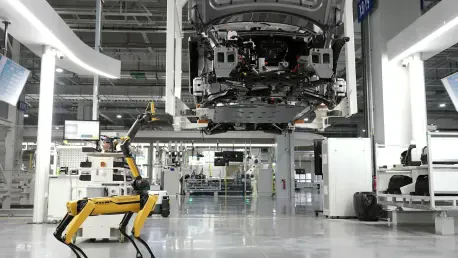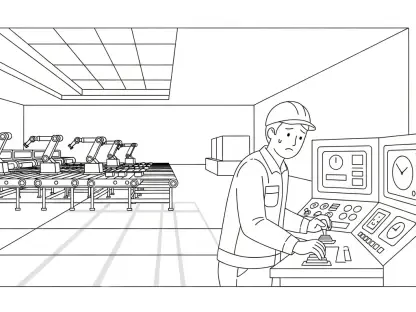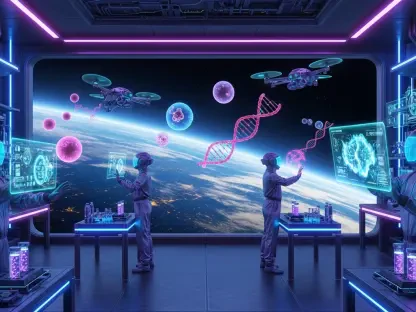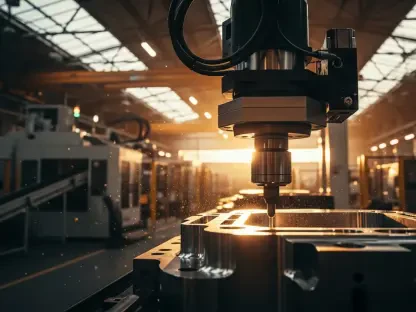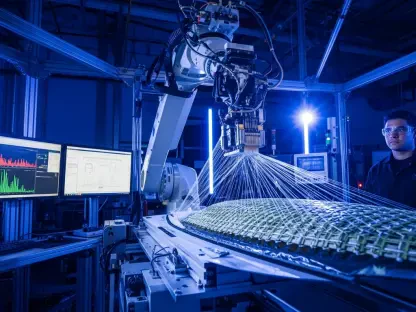In an era where artificial intelligence permeates nearly every industry, engineering stands at a critical crossroads with over 60% of firms reportedly integrating AI tools into their workflows, according to recent industry surveys. This staggering adoption rate raises a pressing question: is AI genuinely transforming the field of engineering, or is it merely a buzzword amplified by lofty promises? The hype often overshadows the reality, creating a divide between expectation and practical impact. This roundup article aims to cut through the noise by gathering insights, opinions, and experiences from a variety of industry leaders, engineers, and technology analysts to provide a balanced view on AI’s role in engineering today. By exploring diverse perspectives, the goal is to uncover whether AI is a game-changer or just another tool in the ever-evolving toolkit of engineers.
Exploring AI’s Current Role in Engineering
The Promise of Efficiency and Innovation
Across multiple sectors, AI is hailed as a catalyst for efficiency in engineering, particularly in automating repetitive tasks. Industry leaders often point to AI’s ability to handle complex processes like dimensioning in computer-aided design (CAD) systems and predicting equipment failures through advanced analytics. For instance, AI-driven tools have been credited with reducing design iteration times by significant margins, allowing engineers to focus on creative problem-solving rather than mundane calculations. This shift is seen as a major win for productivity, with many firms reporting improved throughput in early deployments of such technologies.
However, not all feedback is glowing with optimism. Some engineering professionals argue that while AI excels in structured environments with abundant data, its impact on innovation remains limited. They suggest that these tools primarily optimize existing workflows rather than inspire groundbreaking designs or solutions. This perspective highlights a crucial debate: does AI’s efficiency translate into true transformation, or is it merely a sophisticated upgrade to traditional methods?
Real-World Applications and Early Successes
Diving deeper into practical applications, AI’s integration into predictive maintenance stands out as a key area of success. In industries like manufacturing and energy, AI systems analyze vast datasets to forecast equipment issues before they occur, minimizing downtime and cutting costs. Feedback from early adopters indicates that such implementations have led to measurable gains in operational reliability, reinforcing the notion that AI can deliver tangible value when applied to specific, data-rich scenarios.
Yet, there remains a chorus of skepticism about the scalability of these successes. Some engineers caution that the benefits are often confined to well-funded organizations with access to robust data infrastructure. Smaller firms, they argue, struggle to replicate these results due to resource constraints, raising questions about whether AI’s impact is universal or selectively advantageous. This disparity fuels ongoing discussions about the accessibility of AI tools across the engineering landscape.
Challenges and Limitations of AI in Engineering
Struggles in Complex, Dynamic Environments
Despite the enthusiasm, AI’s limitations become apparent in dynamic, data-sparse industrial settings such as oilfields or remote infrastructure projects. Many industry analysts note that AI models, heavily reliant on historical data, often falter when faced with unpredictable variables or insufficient information. In these scenarios, traditional physics-based approaches frequently outperform data-driven systems, as they better account for real-world uncertainties that AI struggles to interpret.
Moreover, high-stakes environments reveal another critical shortfall: AI’s inability to adapt to rapidly changing conditions without human intervention. Reports from field engineers highlight instances where AI recommendations led to suboptimal decisions due to a lack of contextual understanding. This underscores the persistent need for human oversight, particularly in sectors where safety and precision are non-negotiable, prompting a reevaluation of how much trust can be placed in automated systems.
Risks of Over-Reliance on Narrow AI Tools
A recurring concern among engineering professionals is the risk of over-reliance on narrow AI tools that excel in specific tasks but lack broader reasoning capabilities. Such dependency can create blind spots, especially when engineers defer too heavily to AI outputs without critical scrutiny. Industry feedback suggests that this overconfidence has occasionally resulted in costly errors, particularly in projects requiring nuanced judgment beyond the scope of current AI algorithms.
To mitigate these risks, many advocate for a balanced approach where AI serves as a supportive tool rather than a decision-maker. This perspective emphasizes the importance of training engineers to interpret and challenge AI-generated insights, ensuring that technology complements rather than dictates outcomes. The consensus leans toward fostering a culture of skepticism and verification to safeguard against the pitfalls of unchecked automation.
Emerging Trends and Future Possibilities
Cutting-Edge Developments in Engineering AI
Looking at the horizon, emerging technologies like Scientific Machine Learning (SciML) and agentic AI are generating buzz for their potential to address current gaps. SciML, which integrates physics-based modeling with machine learning, is praised for its ability to simulate complex behaviors rapidly, offering a promising avenue for more accurate predictions in engineering challenges. Similarly, agentic AI systems, capable of automating multi-step workflows, are seen as a step toward more autonomous problem-solving in controlled settings.
Analysts, however, temper excitement with caution, noting that these innovations are still in nascent stages and require substantial refinement. Feedback from tech developers indicates that while pilot projects show encouraging results, widespread adoption across industries could take several years due to integration complexities. This measured outlook suggests that while the future holds promise, immediate expectations should remain grounded in practical timelines.
Bridging Gaps with Real-Time Integration
Another focal point of discussion is the need for platforms that unify real-time data, physical principles, and computational power. Industry visionaries argue that such systems could revolutionize how engineers tackle imperfect, evolving conditions by enabling continuous learning and adaptation. The potential to apply these capabilities globally, from urban infrastructure to remote energy grids, is viewed as a transformative leap that could redefine operational standards.
Yet, opinions differ on the feasibility of achieving this integration swiftly. Some technology experts warn that the infrastructure required for seamless, real-time AI deployment is still underdeveloped, particularly in regions with limited digital connectivity. This divergence in views highlights a broader challenge: ensuring that advancements in AI are not only innovative but also equitable and accessible to diverse engineering communities worldwide.
Collaboration as the Cornerstone of AI in Engineering
Amplifying Human Expertise Through AI
A unifying theme across discussions is the symbiotic relationship between AI and engineers, where technology amplifies rather than replaces human expertise. Many professionals emphasize that AI tools are most effective when they augment an engineer’s ability to analyze, innovate, and make informed decisions. This collaborative model is seen as essential for addressing complex industrial challenges that require both computational power and human intuition.
Contrasting views emerge when comparing Silicon Valley’s ambitious predictions of near-autonomous systems with the more pragmatic reality of narrow AI applications. While some tech enthusiasts push a narrative of inevitable automation, seasoned engineers advocate for a focus on incremental improvements that prioritize partnership over replacement. This grounded approach resonates widely, as it aligns with the day-to-day realities faced by those in the field.
Evolving Roles Over the Coming Decade
Speculation on how this partnership might evolve over the next decade points to the creation of smarter, more sustainable industrial systems. Insights from industry forums suggest that engineers will increasingly adopt hybrid roles, blending technical proficiency with AI literacy to navigate an interconnected landscape. This shift is anticipated to foster resilience in sectors like energy and transportation, where efficiency and sustainability are paramount.
Differing opinions on the pace of this evolution persist, with some believing rapid advancements will redefine roles sooner than expected, while others foresee a slower, more deliberate transition. Regardless of the timeline, the consensus holds that continuous learning and adaptability will be critical for engineers to thrive alongside AI, ensuring that human ingenuity remains at the core of progress.
Key Takeaways from the AI-Engineering Discourse
Reflecting on the wealth of perspectives, a core insight emerged: AI proves to be a powerful enhancer of engineering talent rather than a replacer, with real benefits already evident in streamlined processes and improved outcomes. The discussions consistently highlighted that while AI’s capabilities are impressive in specific domains, its limitations necessitate a collaborative approach to maximize impact. This balance between enthusiasm and realism shaped the narrative around AI’s role in the field.
For engineers and firms looking to integrate AI effectively, the advice centered on fostering collaboration and prioritizing continuous skill development. Adopting hybrid models that combine human judgment with AI-driven insights was often recommended as a strategic starting point. Additionally, investing in training programs to build familiarity with emerging tools was seen as a way to stay competitive in a rapidly shifting environment.
Looking ahead, actionable steps included piloting AI solutions in low-risk settings to build confidence and scalability, as well as advocating for industry-wide standards to ensure ethical and equitable use of technology. These practical measures were frequently cited as essential for navigating the complexities of AI integration. As the conversation continues, exploring further resources on hybrid workflows and case studies of successful AI deployments offers a valuable next step for deepening understanding and driving informed decision-making.
